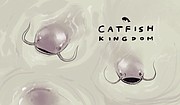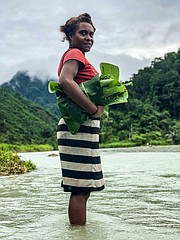This year's Crossroads Film Festival allows participants to stream any of the event's 18 films on their own time through the festival's end on Dec. 15. Films cover a variety of genres and themes and last anywhere from seven to 108 minutes. Read our writers' reviews of select films below.
'Warrior Women'
Over this last year, many of us have become more aware of the plights that certain demographics face in this country—as we witnessed a resurgence of the Black Lives Matter movement, with protesters organizing across the nation to speak out against racial injustice. Interestingly, the documentary film "Warrior Women" addresses a similar movement by taking a close look at the American Indian Movement of the 1970s, which fought for Native American liberation and for survival as a community of extended family.
Mother-daughter duo Madonna Thunder Hawk and Marcella Gilbert—both enrolled members of the Lakota tribe living in South Dakota—narrate the film. The film first contextualizes the historic oppression incurred against Indigenous populations that resulted in decades of inequality and subjugation from the United States. government. Afterward, a scene depicts Gilbert teaching children that the tribe is still living through consequences of a government that reneged on its responsibilities contained in an 1868 treaty.
Once the narrators finished establishing context, the film weaves in the significance of continuous activism, hammering home the message that change occurs when people work together to proclaim the power of collective action. Years ago, for example, Thunder Hawk, an AIM leader, helped shape a group of activists' children in the "We Will Remember" Survivor School, which served as a Native alternative to government-run education.
Scenes show Thunder Hawk reminiscing about what she learned from her involvement in AIM, "Indian Power" messaging, occupation of Alcatraz Island and the Wounded Knee uprising. These experiences taught her about mobilization and committing to a cause, which guided her during the North Dakota protests opposing the Dakota Access Pipeline project.
Like many founding members of Black Lives Matter, the central characters in the documentary are women. In addition to the two narrators, the community of Lakota and Native women are shown to generally spearhead the grassroots initiatives to fight for environmental preservation, cultural education and relationship-building among tribes.
"Warrior Women" reminds viewers that the Native struggle for sovereignty and cultural reclamation is far from over, but that many movement leaders remain steadfast in their activism efforts. —Mike McDonald
'Unadopted'
A layperson would probably acknowledge the complexities of the fostercare system, placing into account their interactions with government, the size of the bureaucracy, and the carefulness (or negligence) associated with human lives. "Unadopted" casts light on those possible assumptions, as the main figure and narrator discusses his own hardships and confusion living within the foster system, interviewing several teenagers who have had their own experiences.
Noel was 7 years old when he became a child in the California state foster system, separated from his older sister who was assigned to a foster family in Idaho. As the years passed, he, like many individuals before and after him, began to wonder what his life would have been like if the people biologically related to him were all in one place and things operated as they should in a dreamscape. However, as he recounts in the film, foster children know that reality can act as rebuttal to fantasy.
He seeks to understand the peculiarities of his case. He is no longer a foster child curious about the reason or reasons he was never adopted. Instead, he contends that the failure to adopt reflects as a failure of the system as a whole. Seeking to uncover details of his background, he aims to reconnect with his mother, who expresses remorse and contrition that she was not able to care for him.
Later, he finds comparative understanding with teenagers who have also undergone their own journeys as foster children: one who was offered adoption but declined, one who was legally adopted and has no desire to meet her biological mother, and another who left the bureaucratic environment entirely to fend for herself on the streets of Oakland. Each person has their own path of self-discovery and must reconcile their desire to know with the harsh reality of what they may find.
"Unadopted" presents viewers with a human portrait of the people who share experiences many of us outside the foster system cannot fully understand. Someone who may be considered a typical teenager at first glance may be engaging in issues of identity and emotional development, yet the foster child must contend with normality atop instability and uncertainty, trying to discover where they came from with each passing glance in the mirror. —Mike McDonald
'Paper Boats'
The opening credits of "Paper Boats" showcase the laurels that the short film has garnered in other film festivals, and it's apparent from the outset that the film deserved each of them, as the subtle opening score matches the almost melancholic ambiance of a young artist at work on a set of paper-making creations. The artist's mentor visits and reminds her of the sufferings she endured in her past, triggering a series of flashbacks.
The film then takes a dark turn and addresses how the artist and her mentor forged their relationship—the former revealing her own assault at the hands of her father. The mentor, a guidance counselor, advocates for the young woman and removes her from her dangerous situation.
While the bond between the artist and her mentor is undeniable, it is also complicated. The artist failed to remove her sister from the clutches of their father, and that sister is now missing. The narrator is left bound to a past she would rather forget, but she must retain her identity to remain accessible to her sister, whom she hopes will return and absolve her from her regret.
The mentor, too, ties the narrator to her adolescence, and the artistry of the movie pivots around this tension. The mentor forces the artist to confront her past, reminding her that she formed her true identity through what she overcame, not what she suffered. The narrator attempts to make a tenuous peace with this, and the movie suggests that because her discovered joy and triumph exist on the same spectrum as her loss and perceived failure, she cannot have one without the other, and she must find a way to reconcile her dark past with her bright future. —Taylor McKay Hathorn
'Catfish Kingdom'
"He was just my dad," Ed Scott Jr.'s daughter says in her voiceover for the eight-minute documentary. Though she never appears on the screen, she narrates her father's journey to becoming the first non-white owner of a catfish plant in the United States.
Though the film does not downplay the role of racism in Scott's struggle, his daughter provides glimpses of the humor and the salt-of-the earth goodness that her father possessed, humanizing him beyond the legislation that marred his career.
Animations creatively depict the ups and downs of his journey—the motion of the fish placing Scott on the map propelling the viewer to the next phase of Scott's life. Even in the climax of the video, when police come to shut down his business over racially motivated interpretations of farming laws, the focus remains on the animated catfish swimming upstream as they follow the arc of Scott's life and business.
This creative ploy works well, even as the storyline becomes grim: Scott's business is repossessed, and he begins a multi-year court battle to regain it. At this point, a 1985 interview with Scott is played, the only non-animated feature of the film. Scott humbly brushes off the praise he receives, claiming that his own successes speak more broadly to the successes of the community.
While the film reinforces his claim, recounting the jobs he provided to other African Americans, the film eventually returns to his daughter's narration. She states that her father's 2012 case against the racial politics that seized the farm was the last one of its kind, enabling her father to hand the check that would allow him to repurchase his farm from the very man who had seized it.
"The arbiter let my daddy tell his story," she says. "Catfish Kingdom" does the same, soulfully relating Scott's troubles while ensuring that the film itself sings of triumph. —Taylor McKay Hathorn
'The Tides That Bind'
For Clint Buffington, finding messages in a bottle is a way of "opening a window into the life of a stranger," and the documentary plays off this idea, featuring Buffington's search for bottles along waterways and highlighting his response to locating such messages.
Although unearthing a bottle bearing a message is often thought of as a matter of serendipity, Buffington has made it a matter of science, studying tide patterns and floodlines to heighten his chances of discovering a message. Once he finds such a missive, the film is clinical in its exploration of Buffington's subsequent actions, depicting his process of reconstructing messages that have been damaged by tides or the sun and using a diamond drill-bit to open a bottle without damaging its contents.
Merely locating the message is unsatisfying for Buffington, with the majority of the film focusing on his quest to locate the senders of the encapsulated messages, though many years often separate the writing of the message and Buffington's discovery.
Buffington is portrayed as earnest in the extreme, often remarking that he was "meant to find" the messages and that he is single-minded in his determination to locate their senders. He does this with varying degrees of success, as the awkwardness of some meet-ups is undeniable, with the senders clearly not expecting such an enthusiastic response to their one-off epistles.
The documentary does not try to mask this, nor does it expect viewers to view these encounters as a detriment to the story, as the journey of the bottle itself and Buffington's appreciation of that journey are often the focus of the narrative.
Indeed, viewers are challenged—though not in so many words—to usurp the norms of the digital age throughout the video, with the meaningfulness of sending a written message—particularly one that is not guaranteed to be read or responded to—highlighted at every turn. —Taylor McKay Hathorn
'Grapefruit'
In this postmodern spin on Walt Disney's "Cinderella," an unlikely fairy godmother (a mustached puppet with a patched coat) promises a grapefruit that he will transform it into a person so that it can find its one true love. The grapefruit consents, and a beautiful woman emerges from the refrigerator, intent on finding the love of her life.
The short film then takes a sharp detour as the woman glories in her bodily form yet seems confused by its limitations, taking shots of dishwasher detergent and smearing peanut butter on her face.
"Grapefruit"'s gag reel ends abruptly when the woman catches a glimpse of the love of her life, and the movie's strongest feature—the original music—is on full display: The woman sings in front of the windows and doors that separate her from the love of her life. The song is surprisingly stirring, full of longing and the desperation to act on that yearning without the possibility of being let down.
As a viewer, it's almost paralyzing to watch her weigh her options, as you dread her consignment to a life as fridge fodder while still fearing the ways she might embarrass herself if she does risk it all for love.
The woman does take the initial step toward her freedom and her supposed love, though the movie is deliberately ambiguous in answering whether the woman's true goal is freedom or love.
In a surprise ending, the woman returns to her roots (quite literally) to keep the clock from striking midnight on her dream of keeping her new form, and viewers are again left wondering whether the musical score about longing and unrequited love was merely an expression of her dissatisfaction with her current station in life.
The film's director seems to indicate that only those who are brave enough to take their discontentment into their own hands will ever rid themselves of it—an unexpectedly deep twist for a film that features a woman dancing in a skirt made of a trash bag in its earlier scenes. —Taylor McKay Hathorn
'SKY AELANS'
The documentary "SKY AELANS," which translates to "Sky Islands" in English, focuses on the South Pacific nation of the Solomon Islands in greater Oceania. The brief film (six-minute duration) could easily deceive the viewer into thinking they are watching the National Geographic Channel or a program on BBC, half expecting David Attenborough to suddenly offer observations on flora and fauna of the island.
Sweeping camera angles pay homage to the title of the piece, whereby the expanse of the land and surrounding ocean can be thoroughly appreciated from a wide lens. The stars and narrator of the film are the Indigenous people, who speak in a Solomon Pijin tongue and communicate their relationship with the land and all who inhabit it, knowing the environment is both sacred and precious.
During the film, the camera also zooms on individual species of plants, reptiles and amphibians, showing off samples of the island's ecosystem. The narrator describes these elements at the sum animating the landmass each morning as they wake. All represented creatures seem exotic and add further credence to the relatively untouched landscape miles away from the urban centers dotting the international map.
The narrators' central message, no matter which specific island being depicted, is the need to protect the environment from exterior forces. Viewers could surmise that these forces include excess industrialism and the commercialization that often accompanies urban areas. The Solomon Islands' government ruled development to be off-limits for elevations above 400 meters.
Island residents consider themselves cogs in the island machinery, working within ecosystems and recognizing the balance achieved by every living creature and the fragility of each biome. They also recognize their place within space and time—that their presence is brief and the trees and rocks and streams will outlast them, inuring a responsibility to care about the treasures the Great Spirit has entrusted upon them. I believe we could all learn a lesson from their appreciation of the land. —Mike McDonald









